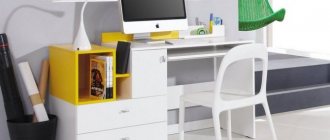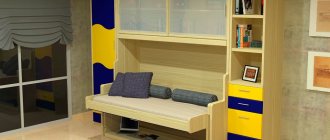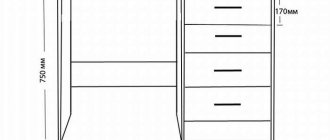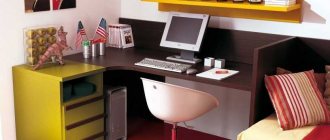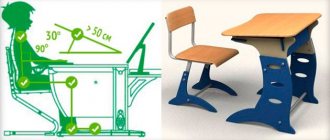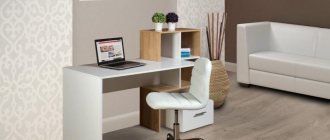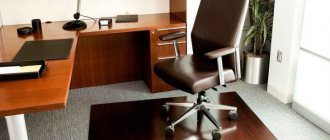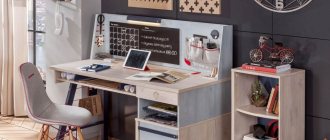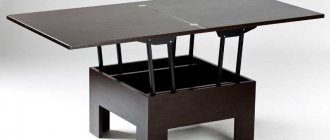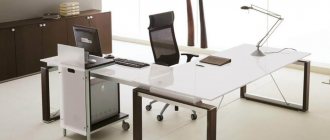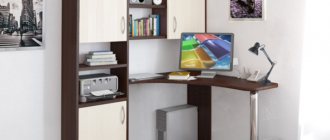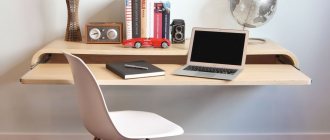Requirements for a desk for a schoolchild
You can optimally organize a workplace for a student by following just a few rules:
- the height of the desk and chair must correspond to the height of the child;
- The optimal ratio is when the table top is at the height of the child’s chest. A table that is too low will force the student to constantly bend over while “lying down” on the desk. This will lead to constant overstrain of the back and neck muscles, which can put pressure on internal organs and contribute to the development of scoliosis. A table that is too high will increase the strain on the neck and shoulder girdle. Prolonged work at a high or low table leads to tension in the eye muscles and can cause vision impairment (for example, accommodation spasm);
- It’s good if the tabletop can be raised at an angle of up to 15 degrees. The child will not tilt his head forward and will become less tired when doing homework;
- There should be no oilcloths, tablecloths or other similar coverings on the writing table. They interfere with writing and distract attention;
- The tabletop area should be sufficient to accommodate a book stand, stacked books, notebooks, and writing instruments.
What is the difference?
At first glance, it seems that a computer desk and a writing desk do not have any particular differences from each other. Both options represent a horizontal plane with legs, behind which a company employee is located. But there are still differences.
The written version is intended mostly for working with documentation and reading. There should be shelves where you can lay out papers, folders and books, as well as stationery.
A computer desk is considered a type of desk, but it has a slightly different configuration. Here, for comfortable work and proper organization of space, you need a pull-out shelf for the keyboard, a compartment for installing the system unit, and holes for running the cable. But if such a table has a wide enough tabletop, then it can be used both for working with documentation and for installing a computer.
Types of tables
If we consider the design of desks, there are several types. The simplest option is direct, also called standard. It has a tabletop that is attached to legs or side supports. It’s easy to organize a workspace here, and you can also install a laptop. There are models that have cabinets and shelves; this option is more suitable for schoolchildren and students than for office workers. In such tables there is often space where you can install a laptop or monitor.
Corner options will help save more useful space; they will not take up much space in the office, but at the same time the tabletop will allow you to comfortably work with documents. You can also install a monitor here in the corner of the table. The next option is a double table. Two employees can sit here, separated by a partition. Moreover, the partition can be located both in front and on the side.
There are also products on wheels; their main feature is mobility. It is easy to move from one place to another if necessary. Such options may have additional shelves where you can put documentation or other necessary items.
In addition, office tables can be classified according to the material they are made of. Usually MDF or chipboard is used for this. This material has a laminate coating, which improves not only the appearance of the product, but also increases practicality. Also, to increase wear resistance, the edges of the product are covered with PVC film. In addition, glass, steel or plastic are used to make such office furniture. Many steel models have only legs, while the table top and shelves are made of chipboard. But you can find options with a metal tabletop frame. Such models have a high cost, but this justifies the strength of the structure.
If we talk about sizes, there are also differences here. The depth of the product varies from 40 to 70 centimeters. And the length can start from 60 centimeters and even reach two meters. The height here is usually standard, varying between 73-78 cm.
How to choose a desk for a schoolchild? Tips for choosing
The question of which furniture to choose for a schoolchild—a desk, a computer desk, or a desk—is asked by every parent. The final decision is yours, and we focus on the important parameters. Desk:
- You can buy it at once for many years. The desk will not stand idle when the child grows up;
- It’s comfortable not only for a child to work at a desk, but also for an adult, if the need arises (especially in times of coronavirus and remote work);
- huge selection. Even for a minimal price you can buy a corner desk, a desk with drawers and shelves that will fit perfectly into any interior;
- for greater versatility, you can buy a desk adapted for working at a computer (with a hole for wires, a compartment for a system unit, etc.). A computer desk is not suitable for educational purposes - there is not enough space on the tabletop;
- For younger students, the desk may be too large. The child will sit incorrectly, so he will quickly get tired and strain his vision.
School desk for schoolchildren:
- Most models can be adjusted in height to suit the height of the child. The student will always have correct posture;
- many models are sold together with a chair, which can also be adjusted in height;
- Many desks allow you to adjust the tilt of the table top. This creates additional convenience, especially for younger students;
- desks are often equipped with folding elements that can increase the area of the tabletop if necessary. There may also be small drawers for storing office supplies.
Why is a computer desk not suitable for a schoolchild?
A modern student cannot do without a computer. Its use is necessary for many homework tasks.
Therefore, in furniture for high school students, desks and computer desks are often combined by increasing the depth of the table top and adding a retractable shelf for the keyboard and a niche for the system unit to the design. However, for a first-grader this option is undesirable.
Among the arguments against:
- the high cost of such a model , due to which its purchase for children of primary school age is impractical. If you install the monitor on a regular table, then the child will not have enough space for textbooks and notebooks, and the system unit standing under the table will take up part of the space needed for the legs;
- children's love for computer games is well known, and the monitor, constantly in front of the eyes, will remind the child of the virtual battle;
- The restlessness of a small student poses a threat to the computer: a child with a careless movement can knock over the monitor or touch the system unit with his foot, and an expensive item will be hopelessly damaged.
Material
When choosing a material, consider safety, interior design, wear resistance, strength and durability of the base and coating.
- Chipboard (chipboard) is the most common material. It is made from a mixture of shavings and sawdust along with adhesives. This is a cheap and fairly durable material if you do not expose it to excessive moisture and abrasion. Its disadvantages are fragility and the release of formaldehyde.
- LDSP (laminated chipboard) - the same. like high-quality chipboard, but during the production process the sheet is covered with a polymer film. This is also an inexpensive material, but more stable than its classic counterpart - it is not afraid of high temperatures and moisture. Laminated chipboard sheets are very durable and hold fasteners well, which is why furniture manufacturers love them.
- MDF (Medium Density Fiberboard) is made from wood dust using natural adhesives - lignin and paraffin. MDF is a very environmentally friendly material that does not evaporate harmful compounds, is moisture resistant and quite flexible - it can be easily milled. Therefore, MDF furniture often has unusual curved shapes. The main disadvantage of the material is its high price compared to chipboard and laminated chipboard.
- Solid - the table is made of wooden boards tightly fastened together. Solid wood tables are strong, environmentally friendly, durable, wear-resistant, but at the same time heavy and quite expensive.
- Plastic - plastic desks and tables are mainly produced for primary schoolchildren. They are not very durable (in principle, this is not necessary, since the child grows quickly), but at the same time they are inexpensive. In any case, a plastic table will have to be replaced with a more reliable one already in 2-3 grade.
- Glass – Glass desks are not very common. If you decide to buy, it is better for older students, as younger ones can break it and get hurt by the fragments. In addition, glass is a cold material, and in the fall, before the heating is turned on, working at such a table may be uncomfortable.
- Metal - usually used in combined tables, the working surface of which is still made of wood. Often, metal tables are not mass-produced, but are made to order, taking into account the requirements for a specific interior.
What to look for when choosing
Photo by Pexels
A desk is the most expensive thing that parents will purchase when preparing their child for first grade. It is quite difficult for parents to make the right choice, because there is such a wide variety of tables on the market. The last thing parents of a small schoolchild need to do is pay attention to the design delights of this piece of furniture. The main priorities in choosing should be safety, environmental friendliness and convenience.
When choosing a desk for a student in grades 1-5, you need to pay attention to:
- Height and width of the table. If it is too high, you will need to purchase a special chair or a chair whose height is adjustable. If the table is low, the child will hunch over it while working, and there will be a risk of developing spinal curvature. According to sanitary standards, a student should sit at the table so that his elbows are freely placed on the tabletop, and his legs reach the floor and bend at an angle of 90 degrees.
- Tabletop width . It should be wide enough so that all the necessary items can be placed there, and there is enough space left for activities.
- Quality of material. It is also necessary to remember about the quality of the materials from which the table is made. Most often, furniture intended for children is made of laminated chipboard, but you can also purchase a table made of solid wood, plastic or glass.
- Fasteners . Children most often break precisely what, at first glance, looked quite strong.
Equipment
A desk for a schoolchild can have different configurations and appearance. An ordinary table is a classic rectangular shape, with drawers on the side. Under the tabletop there can be a shelf where it is convenient to store textbooks. In such models, the tabletop itself has sufficient area: you can comfortably place a monitor or laptop on it. Tandem table. A convenient option if there are 2 schoolchildren in a family of approximately the same age. As a rule, it is equipped with a common tabletop and a system of drawers in the middle or on the sides. Workstations can be located next to each other, or perpendicular to the same tabletop. Computer deskFor middle and high school age, you can buy a computer desk. Its main difference is the retractable bottom shelf for the keyboard and space for the system unit. You need to pay attention to how much free space will remain on the desk after installing the computer. Not all computer desks are convenient for doing homework: the tabletop is often located higher due to the presence of a pull-out shelf, and there is not enough space for a comfortable position at the desk. Corner table Suitable for small rooms, as it will help to rationally use the corner. Despite its compactness, the corner table boasts a decent countertop area. Often, in addition to the table, manufacturers offer a mini-rack or additional shelves. Table with shelves Often looks similar to a classic rectangular table, but there are different options. The main advantage is the large shelves for storing textbooks, which are installed directly on the table, and there is no need to drill into the wall.
Criteria for choosing a table home for a first grader
A desk for a first-grader at home must meet several important conditions:
- be comfortable;
- well lit;
- roomy;
- durable to withstand children's restlessness and carelessness for a long time;
- have an attractive, modern design.
The parameters of the table are especially important, since the comfort and health of the child depend on them.
Height
A desk that is incorrectly selected in height is a common cause of scoliosis and vision impairment . In addition, it will be inconvenient for the child, which will inevitably affect his desire to study.
To determine the optimal height, you need to measure the student’s height, and then use the following algorithm:
- with a height of 1.1-1.2 m, which is typical for most children 6-7 years old, the height of the table is 52 cm, and the height of the chair is 32 cm;
- for a taller child - for each interval of 10 cm of height, 5 cm of table height and 3 cm of chair height are added.
Arithmetic calculations will help you narrow down the search for the right model, but it is not recommended to rely solely on them when purchasing, since each child has his own physique.
When choosing a table for a first-grader in terms of height, you also need to pay attention to the height of the chair
To check the correctness of the choice, it is recommended to perform a simple test by sitting the baby at the table.
Indicators of a comfortable table and chair that are suitable in height are:
- legs bent at the knees at a right angle and resting on the floor with the entire foot;
- knees located at a distance of 10-15 cm from the bottom of the tabletop;
- table top located at the level of the solar plexus (the area below the chest and above the abdominal cavity).
You should also ask the baby to place his arm bent at the elbow on the table and lift his chin so that it makes a right angle with the neck: the tip of the middle finger should easily reach the outer corner of the eye.
Width
The optimal width of a school table is 1 m. This is enough to provide the student with the necessary work space and at the same time not clutter the room. We are talking about a traditional rectangular table designed for 1 person.
Depth
The depth of the table (width of the tabletop) should be sufficient so that the student can place a notebook and textbook on the table at a distance of 30 cm that is comfortable for the eyes, while his elbows are completely on the table and not hanging over its edge. For simple rectangular school tables, the standard depth is 60 cm.
If the desk will be combined with a computer desk, then a depth of 70 cm is required to ensure sufficient working area and normal distance to the monitor screen.
Color
Distracting bright colors are undesirable for desktops. It is recommended to choose a model of calm, neutral color: beige, cream, light brown. The most popular furniture is light shades imitating natural wood. Of the “color” options, only calm, not too bright shades of green are suitable for the school table.
For a number of reasons, you should not choose a table with a shiny, glossy surface for your baby:
- glare of light reflected from it will disturb the student;
- the slippery coating will create certain inconveniences when placing everything you need on the table;
- Scratches will appear on the shiny tabletop, and it will quickly lose its elegant appearance.
A matte surface is more practical and convenient: it looks attractive, but is devoid of the disadvantages described above.
Table and finishing materials
A table for a first-grader at home must be very durable, because its restless owner is just beginning to learn how to take care of things. At the same time, the table should not pose a danger to the child. Therefore, purchasing expensive furniture made of glass, stone, and metal is impractical.
Preference is given to cheap but durable models made from:
| Material | Description |
| Wood | Wood is a durable, natural, attractive material. However, due to the high cost and the need for regular careful care, it is purchased for a first-grader only in families with a high level of income. |
| MDF | Pressed wood slabs are used to make school tables in the mid-price category. In terms of durability and safety, furniture made from MDF is practically not inferior to its counterparts made from natural wood. It has an equally attractive appearance, but will cost the buyer several times less than wood. |
| laminated chipboard | Laminated chipboard, which is practically no different from MDF board, but captivates with its low cost. It is laminated chipboard that is the main material for the production of school furniture, and tables made from it are constant sales leaders. |
| Chipboard | It is used to produce budget versions of tables, the only advantage of which is their low cost. Furniture made from chipboard is short-lived, not durable, and most importantly, the resins used to make chipboard can emit formaldehyde, which is harmful to humans. When buying a table made of chipboard, you need to make sure that the product meets sanitary standards, for which you ask the seller to present a quality certificate. |
| Plastic | Cheaper and safer than chipboard material, lightweight. The main disadvantage is fragility. Buying a plastic table for a schoolchild is justified only if it is used as a temporary option. |
To finish the ends of the table top and other table elements, edge materials are used in the form of adhesive tapes of a certain width, the color of which usually matches the color of the furniture itself.
Budget models use cheap and unpractical melamine edge strips, while more expensive ones use PVC-based edges. ABS plastic is used for finishing luxury tables.
Purpose of finishing:
- prevent toxic substances from entering the air from the thickness of the slab;
- protect the ends of the product from moisture;
- make furniture safer (untreated sharp edges can cause injury or tear clothing);
- give the product an attractive appearance.
To connect individual parts, fittings made of metal, less often plastic, are used.
Design
Despite the wide variety of desk models, the most popular are the “classic” ones. This is a rectangular table with a bedside table and drawers.
Among its main advantages:
- relative cheapness;
- small sizes;
- Possibility of installation anywhere in the room;
- attractive appearance.
The disadvantage of traditional models is the limited capabilities of the table: it will not be able to “grow” with the child or provide him with an inclined tabletop.
These shortcomings can be partially compensated for by using simple devices:
- if the height of the tabletop and seat is too high, a footrest with enough width to place 2 legs and a depth slightly greater than the length of the baby’s foot will help solve the problem. When the child grows up, the stand can be removed;
- the inclined tabletop, which is more convenient for a first-grader, will be replaced by a stand for a textbook;
- The depth of a seat that is too large can be reduced by placing a pillow or bolster under the child’s back, which will create the necessary support for it.
There are other models of desks for schoolchildren, which, in comparison with the classic version, have a wider range of capabilities:
| Table type | Description |
| L-shaped | It will allow you to install a computer on one side, equipped with a retractable panel for the keyboard and a niche for the system unit. The other side can be used as a desk for a child. |
| Combined | Includes desk and computer desk. Reminiscent of a traditional one, but with a larger tabletop that allows you to additionally install a monitor. Not a very convenient option for a first-grader, which is justified only if it is necessary to strictly save space. |
| Tandem table for two children | If purchasing 2 tables is not possible, for example, if there is a shortage of space, then you can choose tables in which workstations are located:
|
| Table transformer | The design has a mechanism that allows you to adjust the height of the tabletop and its angle of inclination. This option will not be cheap, but in the future it will save money on purchasing a new desk for an older student. |
Less common options for school tables are various designs that take up minimal space, which are suitable for a small-sized nursery.
Their varieties:
- built-in table, which is an element of the loft bed. The table is on the lower tier, the bed is on the upper;
- folding tabletop.
- folding console table. In this and the previous case, you will need convenient hanging shelves for storing textbooks and notebooks.
An analogue and competitor to a table is a desk; this type of student furniture is becoming more popular because it has several advantages:
- makes it possible to adjust the height and tilt of the tabletop;
- has a footrest;
- differs in small size.
Disadvantages include high cost and insufficient strength of individual elements.
Functionality, drawers and shelves
A table for a first-grader for home, as a rule, is equipped with a bedside table on the right or left edge, which has 2-3 shelves, and a drawer under the tabletop. This is enough to neatly arrange the student's learning items.
Sometimes an option with 2 bedside tables on the sides is used; models are produced with bedside tables on wheels, which are an independent design element and can be installed under the tabletop, on the right, on the left or next to the table.
Whatever option is chosen, it is important to leave free space for the legs under the tabletop with dimensions of 50x50, otherwise the table will be uncomfortable. When buying a table, you need to check how easily and silently the drawers can be pulled out, and also make sure that there are no parts that could injure a child.
The following can be used as additional storage space for textbooks:
- bookcases;
- bookcases;
- shelves;
- racks.
These structures must be safe, located at a height convenient for the child and not take up too much usable space.
Organization of a schoolchild's workplace
According to the standards, high school students should spend no more than 3 hours on homework. However, in reality, lessons often drag on. To ensure that your child is less tired and his health does not suffer, proper organization of the workspace is important. It is advisable to place the student’s desk near a window to make the most of natural light whenever possible. The light should fall on the left side of the child if he is right-handed, and on the right if he is left-handed. In this case, the shadow of the hand does not fall on the written text, and the eyes are less strained. The table must have a table lamp with the ability to adjust the height and tilt. The workspace should be well lit with natural light or a desk lamp. The light from the chandelier in the room may not be enough. Lighting that is too dim or too bright puts extra strain on the eyes and can impair vision. A chair or armchair for a schoolchild must have a backrest. It would be nice if the chair can be adjusted in height. A child, sitting on a chair, should rest his feet firmly on the floor or, in extreme cases, on a special footrest. Legs hanging from the chair are unacceptable - this posture leads to improper distribution of static load on the musculoskeletal system and develops stooping. While sitting, your legs should be bent at the knees at a right angle. If the chair is too low, the knees form an acute angle, and prolonged sitting in this position can lead to kyphosis, a curvature of the spine in the thoracic region.
Review of table models
Halmar Lima B1
Desk with bedside table and drawer. Made from laminated chipboard. Has a classic shape. Suitable for any interior.
Mebelgrad SP-02
A simple rectangular desk. Made from laminated chipboard. Does not have shelves or drawers.
Sokol KST-106.1
Universal large table. Due to the area of the table top and the layout of the elements, it can be used both as a desk and as a computer desk. Made from laminated chipboard. Has one shelf, one cabinet and 4 drawers.
The best computer desks with cabinets
The third category of the top rating represents functional but compact furniture, where, in addition to the work area for the computer, there are drawers and closed cabinets for storing personal belongings. According to the results of the comparative analysis of VyborExpert, 2 nominees became leaders.
Mebelson Manhattan
Classic desk with 6 closed drawers. The matte body looks modern, as do the pleasant shades available to choose from. Manufacturer: Russian furniture factory Mebelson.
The assembly of the structure is universal. When creating it, the material used was laminated chipboard E1, the thickness of the facades is 1.6 cm, the tabletops are 2.5 cm. PVC film is applied on top, it makes the laminated coating matte. There are 6 drawers with a full extension mechanism for office supplies and personal items.
Overall dimensions – 120x70x76 cm with a weight of 61 kg. There are 2 color options to choose from - shimo ash, cappuccino. The housing is mounted on plastic supports to protect the floor from damage. Handles are plastic.
Advantages:
- Matte finish;
- Pleasant color combination;
- Plastic supports;
- Arrangement of drawers on any side;
- Compactness;
- Price.
Flaws:
- The drawers do not extend completely;
- Simple edges.
The side of the drawers is chosen by the customer; it can be either left or right. The opening mechanism works smoothly. The fittings were brought from Europe. Buyers note that the colors are more contrasting than in the store catalog.
MfMaster Renzo-2
A compact model in a minimalist style, where there is nothing superfluous, only a work area, an internal shelf, and 3 closed cabinets. Manufacturer: Russian.
The main advantage here is the large stationary tabletop made of high-strength laminated chipboard. Additionally, there is an open shelf underneath, but it is practically hidden from view. On the side there are 3 drawers with ball metal guides, they can be on the left or right as desired.
Overall dimensions – 120x78x60 cm with a weight of 39.4 kg. There are 5 color options to choose from, only trendy designs that match the modern interior. Decorative plugs that hide the holes are made to match the furniture.
Advantages:
- Large working area;
- Durable coating;
- Compactness;
- Trendy colors;
- High-quality fittings;
- Price.
Flaws:
- Narrow drawers in the cabinet;
- No handles.
The laminated chipboard is coated with a protective coating against moisture, dirt, chips and scratches. Assembly is simple, the instructions are clear, and the kit contains all the necessary parts. Visually, the model looks easy. There are no handles, the drawers open with edge gaps.
